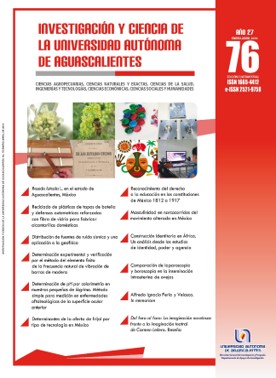Distribución de fuentes de ruido sísmico y una aplicación a la geofísica
DOI:
https://doi.org/10.33064/iycuaa2019761788Palabras clave:
Ondas P y SV, función de Green, distribución de energía, fuentes sísmicas, campos de desplazamientoResumen
Mediante la correlación del ruido sísmico es posible recuperar una de las características más importantes de la estructura del medio donde se propagan las ondas sísmicas llamada función de Green. Es necesario estudiar la influencia que guarda la distribución del ruido sísmico para poder estimar si la función de Green recuperada será o no precisa. Este trabajo muestra una formulación que permite obtener la función de Green para diferentes distribuciones de fuentes de ruido sísmico. Primero se utilizan las funciones de Green exactas y se estudian los contenidos de energía de las ondas P y SV. Después, se exhibe la relación de la función de Green exacta y aquella recuperada mediante ruido sísmico. Posteriormente, se analizan varias distribuciones de fuentes sísmicas, principalmente isotrópicas y colineales, y se exponen algunos elementos que permiten valorar cuál de ellas pueden conducir a obtener con buena correlación de la función de Green.
Descargas
Métricas
Citas
• Aki, K. (1957). Space and time spectra of stationary stochastic waves, with special reference to microtremors. Bulletin of the Earthquake Research Institute, 35, 415-456.
• __________, & Richards, P. G. (2002). Quantitative seismology (pp. 11- 34). US: University Science Books.
• Brown, M. G., & Lu, C. (2016). Green’s function retrieval in a field of random water waves. Wave Motion, 60, 8-19.
• Campillo, M., & Paul, A. (2003). Long-range correlations in the diffuse seismic coda. Science, 299(5606), 547-549.
• Garnier, J. (2005). Imaging in randomly layered media by crosscorrelating noisy signals. Multiscale Modeling & Simulation, 4(2), 610-640.
• Garus, D., & Wegler, U. (2011). The Green’s functions constructed from 17 years of ambient seismic noise recorded at ten stations of the German Regional Seismic Network. Bulletin of the Seismological Society of America, 101(6), 2833-2842.
• Ma, S., & Beroza, G. C. (2012). Ambient-field Green’s functions from asynchronous seismic observations. Geophysical Research Letters, 39(6), L06301. doi: 10.1029/2011GL050755
• Ryzhik, L. V., Papanicolau, G. C., & Keller, J. B. (1996). Transport equations for elastic and other waves in random media. Wave Motion, 24(4), 327-370.
• Sánchez-Sesma, F. J., & Campillo, M. (1991). Diffraction of P, SV and Rayleigh waves by topographic features: A boundary integral formulation. Bulletin of the Seismological Society of America, 81(6), 2234-2253.
• Sánchez-Sesma, F. J., Pérez-Ruiz, J. A., Luzón, F., Campillo, M., & Rodríguez-Castellanos, A. (2008). Diffuse fields in dynamic elasticity. Wave Motion, 45(5), 641-654.
• Sato, H., & Fehler, M. C. (1998). Seismic wave propagation and scattering in the heterogeneous Earth. US: Springer-Verlag.
• Shapiro, N. M., & Campillo, M. (2004). Emergence of broadband Rayleigh waves from correlations of the ambient seismic noise. Geophysical Research Letters, 31(7), L07614. doi: 10.1029/2004GL019491
• Stehly, L., Campillo, M., & Shapiro, N. M. (2006). A study of the seismic noise from its long-range correlation properties. Journal of the Geophysical Research, 111, B10306. doi: 10.1029/2005JB004237
• Van Manen, D. J., Curtis, A., & Robertsson, J. O. (2006). Interferometric modeling of wave propagation in inhomogeneous elastic media using time-reversal and reciprocity. Geophysics, 71(4), SI47-SI60.
• Wapenaar, K. (2004). Retrieving the elastodynamic Green’s function of an arbitrary inhomogeneous medium by cross correlation. Physical Review Letters, 93, 254301-1-254301-4.
• Weaver, R. L. (2005). Geophysics. Information from seismic noise. Science, 307(5715), 1568-1569.
• __________, & Lobkis, O. I. (2004). Diffuse fields in open systems and the emergence of the Green’s function. The Journal of the Acoustical Society of America, 116, 2731-2734. doi: 10.1121/1.1810232
Descargas
Publicado
Cómo citar
Licencia
Las obras publicadas en versión electrónica de la revista están bajo la licencia Creative Commons Atribución-NoComercial-CompartirIgual 4.0 Internacional (CC BY-NC-SA 4.0)









